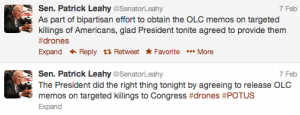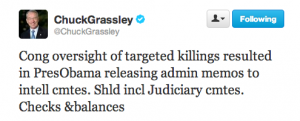As important as it is to see the white paper DOJ gave Congress to explain its purported legal rationale, it is just as important to make clear what this white paper is not.
First, is it not the actual legal memos used to authorize the killing of Anwar al-Awlaki and who knows who else. As Michael Isikoff notes in his story, the Senators whose job it is to oversee the Executive Branch — even the ones on the Senate Intelligence Committee that are supposed to be read into covert operations — are still demanding the memos, for at least the 12th time. The release of this white paper must not serve to take pressure off of the White House to release the actual memos.
Which brings me to an equally important point: memos. Plural.
NBC suggests and the close tracking appears to support that this white paper is a version of the OLC memo written in June 2010 and reported on — the last time there was clamor to release the targeting killing authorization publicly — by Charlie Savage.
But as Colleen McMahon strongly hinted last month, that doesn’t mean that this white paper — and the OLC memo which it summarizes — describe the legal basis actually used to kill Anwar al-Awlaki.
Indeed, Ron Wyden has been referring to memos, in the plural, for a full year (even before, if Isikoff’s report is correct, this white paper was first provided to the Committees in June 2012).
And there is abundant reason to believe that the members of the Senate committees who got this white paper aren’t convinced it describes the rationale the Administration actually used. Just minutes after Pat Leahy reminded the Senate Judiciary Committee they got the white paper at a hearing last August, John Cornyn said this,
Cornyn: As Senator Durbin and others have said that they agree that this is a legitimate question that needs to be answered. But we’re not mere supplicants of the Executive Branch. We are a coequal branch of government with the Constitutional responsibility to conduct oversight and to legislate where we deem appropriate on behalf of our constituents. So it is insufficient to say, “pretty please, Mr. President. pretty please, Mr. Attorney General, will you please tell us the legal authority by which you claim the authority to kill American citizens abroad?” It may be that I would agree with their legal argument, but I simply don’t know what it is, and it hasn’t been provided. [my emphasis]
More importantly, one question that Wyden keeps asking would be nonsensical if he believed the content of this white paper reflected the actual authorization used to kill Awlaki. [Update: I take this part back — go read this post for why Wyden keeps asking this question.]
This white paper, after all, speaks repeatedly of the AUMF and invoked Congressional approval (this is just a limited sampling).
The United States is in an armed conflict with al-Qa’ida and its associated forces and Congress has authorized the President to use all necessary and appropriate force against those entities. See Authorization for Use of Military Force.
[snip]
Accordingly, the Department does not believe that U.S. citizenship would immunize a senior operational leader of al-Qa’ida or its associated from a use of force abroad authorized by the AUMF or in national self-defense.
[snip]
None of the three branches of the U.S. Government has identified a strict geographical limit on the permissible scope of the AUMF’s authorization.
[snip]
In such circumstances, targeting a U.S. citizen of the kind described in this paper would be authorized under the AUMF and the inherent right to national self-defense.
[snip]
And judicial enforcement of such orders would require the Court to supervise inherently predictive judgments by the President and his national security advisors as to when and how to use force against a member of an enemy force against which Congress has authorized the use of force. [my emphasis]
But Ron Wyden, who has gotten this white paper, still keeps asking this question.
Is the legal basis for the intelligence community’s lethal counterterrorism operations the 2001 Congressional Authorization for the Use of Military Force, or the President’s Commander-in-Chief authority?
Now, to be fair, those bolded sections do hint at something else, the reliance on inherent authority. And in an early passage laying out the authorities, the white paper lists that Article II authority first, well before it lists the AUMF.
The President has authority to respond to the imminent threat posed by al-Qa’ida and its associated forces, arising from his constitutional responsibility to protect the country, the inherent right of the United States to national self defense under international law, Congress’s authorization of the use of all necessary and appropriate force against the enemy, and the existence of an armed conflict with al-Qa’ida under international law. [my emphasis]
But everything about this white paper uses the AUMF — that Congressional authorization — as the key authorization.
This white paper admits the President claims he could kill an American solely on his inherent Article II powers. But that’s not the argument laid out in the white paper.
Now, there are other reasons to believe this is not the authority relied on — at least not for all the attempts to kill Awlaki. After all, when they first tried to kill him on December 24, 2009, the Intelligence Community didn’t believe him to be operational; at that point, according to the knowledge the government had at that time, Awlaki would not meet the three criteria laid out in this memo.
Never fear though! This white paper makes clear that the government may not even need to fulfill those requirements before it offs a US citizen.
As stated earlier, this paper does not attempt to determine the minimum requirements necessary to render such an operation against a U.S. citizen lawful in other circumstances.
Even as shoddy as this argument is — as forced its interpretation of the word “imminent” and the court precedents — this white paper holds out the possibility that there may be other circumstances, other lesser requirements fulfilled, that would still allow the President to kill an American citizen.
And that, I fear, is what is in the real memos.
Update: Note, too, that 9 of the 11 Senators who demanded the memo have seen this white paper (all but Tom Udall and Jeff Merkley are on either the Senate Intelligence of Judiciary Committee). Yet they’re still demanding to know the “executive branch’s official understanding of the President’s authority to deliberately kill American citizens.”


